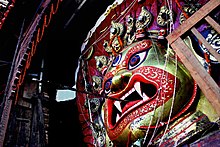

This article should specify the language of its non-English content, using {{lang}}, {{transliteration}} for transliterated languages, and {{IPA}} for phonetic transcriptions, with an appropriate ISO 639 code. Wikipedia's multilingual support templates may also be used. See why. (June 2022)
|
Alcohol (RaksiorMadira) It is legal to produce upto 60 Litres of fermented beverage and distill 30 litres Raksi per year for personal consumption, but it's illegal to sell home-made Raksi spirit in Nepal. The mixed society coupled with caste and multiple ethnic results in an extremely complex social structure which also generally affects alcohol consumption among the people based on their background. There are mainly two types of people in Nepal depending on alcohol use. The group of people who do not drink or use alcohol are called Tagadhari (तगाधारी) (Holy Cord (Janai) Wearer), and the other group who drink alcohol are called Matawali. Traditionally, the Brahmins and Kshatriyas are the Janai wearers and are forbidden from consuming alcohol, with the exception of Matwali ChhetrisofKarnali region who are permitted to use alcohol. Alcohol also plays an important role in rituals, festivals and religious ceremonies. Matwalis largely use alcohol for their traditional purposes and generally brew alcohol by themselves. People such as Tharu, Kirati people, Magar, Gurung, Tamang, Newars[1]
Traditionally, Matwali men are allowed to drink freely while women are somewhat restricted from the open consumption of alcohol despite playing an instrumental role in the preparation of the beverage.

In Hindu culture, alcohol is often described as Soma. In the epic of Ramayana and Mahabharata, there are mentions of drinking alcohol by gods and goddesses as a recreational food. In ancient and medieval Nepal, the Kirats, Shakyas, Lichhavis, etc. had already formed a trade relationship with Tibet, India, and China from whence drinking culture probably entered Nepal. The Lele inscription of Shivadeva I and Amshuverma dated 526 AD mentioned alcohol as Paniyagosthi. In the inscription of Jayalambha dated 413 AD, the word Karanapuja is used referring to the alcohol; the inscription was found near Pashupatinath Temple.[2]
The Christian Father Ippolito Desideri, who travelled Nepal about 1720, had a written account of a pungent-smelling liquor made from millet. He also mentions arac, a drink made from wheat or rice.
In modern Nepal, the Maluki Ain of 1854 categorically classified Nepalese society into five categories. One of them was the Tagadhari who were not allowed to drink, while the remaining four were allowed to drink. In the modern constitution, however, there is no such distinction and everyone is equally allowed to use alcohol according to their personal preference.
Alcohol is used for various rituals by various indegeneious communities especially the one influenced by Tantric methods. Some are described below.[3]
Sherpas use alcohol in marriage and festivals extensively. It is also given to the new mothers as Dejyang. When used as a business settlement, it is called Chhongjyang.

Ha Thon is a festival to worship Swyeta Bhairab in which the Samayabji and Aila is distributed as the blessing of Bhairab. Alcohol also forms a part of Sagan. In gathering and festival (Bhoj), liquor is generally served by a female.
During the marriage, alcohol is offered to deities called Deuryar. In the hair cutting ritual celebrated in Falgun (February -March), alcohol is offered to deities to accept the ritual's starting. Drinking and dancing are one of the core cultures of Tharus.
In the Kirati community, a marriage proposal is not accepted by the girl's family unless the groom sends them alcohol on three occasions as Sodhani, Multheki and Bhakah. Kirati also use alcohol for various rituals and to worship gods and goddesses.
Groom needs to send 18 or 12 bottles of liquor to bride's house for marriage known as Chukunlah Pong. When someone dies, alcohol is offered to the deceased. The daughter brings alcohol to serve the funeral participants.
Couples are not allowed to go to the bride's home after marriage without taking wine and a leg of goat. This is called Duran.
Similar to kirati culture, Gurung family's marriage initiation also starts by sending alcohol to the bride's family by the groom. They also use alcohol as an offering to the deceased person.

A typical traditional beer brewing technique in Nepal consist of following steps:[8]
According to statistics, about 115 kg (254 lb) of rice is used to brew alcohol by Newar family annually, 110 kg by Sherpas, 160 kg by Khumbu and Rolwalingis. Tamang uses 80 kg and 400 kg by Tharus.[9]
Alcohol industry is one of the fastest-growing industry in Nepal. There are 36 alcohol producing industries in Nepal as of 2000.[10] These industries produces alcohol with concentration of 20%, 34%, 40% and 42.8%. Similarly, beers are produced with a concentration of 5 to 7% alcohol. The total production capacity is about 42 M liters per year. Besides, alcohol is also imported from Europe, America and Japan.[10]
Production and consumption of alcohol is controlled by the Madira Aain 2031.[11] Licence is required to sell alcohol. However, it permits brewing and consumption for household purposes without a license.
In 2017, a regulation was passed to set minimum age of 21 for alcohol purchase, regulate time of alcohol sales, require licensing of alcohol outlets and impose a ban on all kinds of alcohol advertisements and promotions. It also includes pictorial warning signs in the label of alcohol.[12]
{{cite journal}}: Cite journal requires |journal= (help)
{{cite journal}}: Cite journal requires |journal= (help)
{{cite journal}}: Cite journal requires |journal= (help)
{{cite journal}}: Cite journal requires |journal= (help)
{{cite journal}}: Cite journal requires |journal= (help)
{{cite journal}}: Cite journal requires |journal= (help)
{{cite web}}: |last5= has generic name (help)CS1 maint: numeric names: authors list (link)
|
Alcohol-related topics by country
| |||||
|---|---|---|---|---|---|
| Countries |
| ||||
| Drinking culture |
| ||||
| Alcoholic drinks |
| ||||
| Laws |
| ||||
| Related |
| ||||